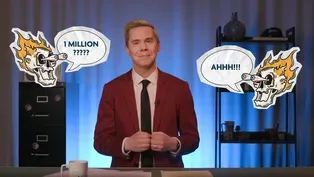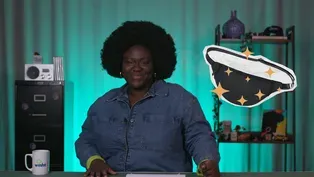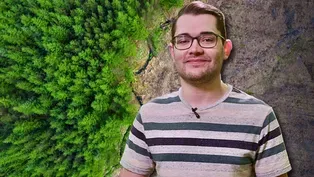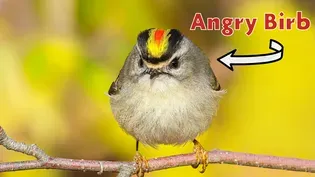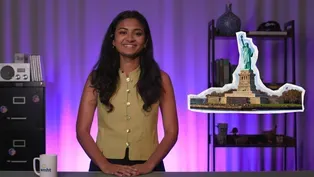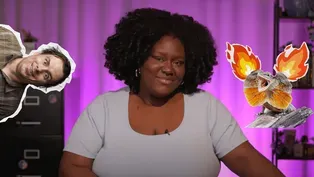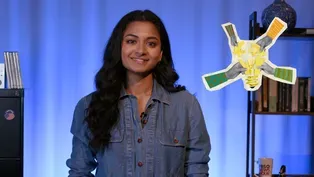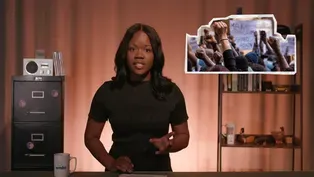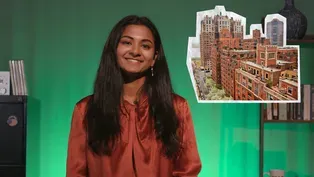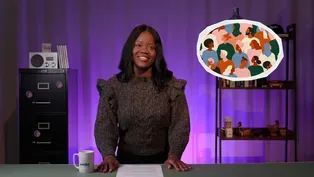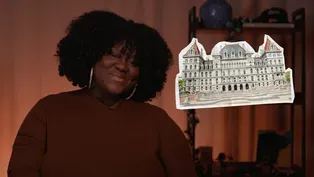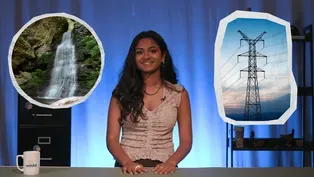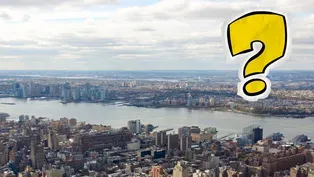
Addressing Air Pollution in New York's Communities | NY& Climate
Clip: Special | 8m 44sVideo has Closed Captions
Join host Dana Wright as he explores air pollution's effect on New York's communities.
Join host Dana Wright as he explores air pollution's effect on New York's communities, and how the state is looking to address it.
New York NOW is a local public television program presented by WMHT

Addressing Air Pollution in New York's Communities | NY& Climate
Clip: Special | 8m 44sVideo has Closed Captions
Join host Dana Wright as he explores air pollution's effect on New York's communities, and how the state is looking to address it.
How to Watch New York NOW
New York NOW is available to stream on pbs.org and the free PBS App, available on iPhone, Apple TV, Android TV, Android smartphones, Amazon Fire TV, Amazon Fire Tablet, Roku, Samsung Smart TV, and Vizio.
Providing Support for PBS.org
Learn Moreabout PBS online sponsorship(gentle upbeat music) - I was going for a jog with Josh Merlis of the Albany Running Exchange.
We were in Watervliet right next to I-787.
787 runs through a densely populated area of the capital region, and due to its proximity to the Hudson River, it also runs by a lot of places where people like to get fresh air and exercise.
But with all of this traffic, is the air really that fresh?
What is it that you think we're breathing in right now from all the cars?
- Well, whatever's coming out of their exhaust pipes, which is not something I really wanna be breathing.
- After our run, during which no cameramen were injured, I kept thinking about air quality.
I, myself, live close to the highway, and I wonder what that means for me and my neighbors.
So I know that those cars were emitting something that's, you know, not good for our health or for the environment, but I'm not sure what, so I'm gonna have to figure that out.
So with these thoughts in mind, I decided to head over to UAlbany's ETEC building where I met up with Dr. Sara Lance, a researcher at the Atmospheric Science Research Center.
We had a quick talk about breakfast.
Are you a ketchup with eggs person - Ew- - or a hot sauce?
- No.
- [Dana] And then got down to business.
If I am standing next to a highway, what are some of the things that I'm likely breathing in in that situation?
- Next to a highway, you're gonna get definitely particulate matter.
Aerosols is another another word for it.
These are particles that are suspended in air.
Each one is too small to see with your eye, but they're always around us.
Actually, in this room right now, we probably have a thousand particles in each centimeter cubed of volume of air.
Coming outta your tailpipe, you're gonna have a lot more.
There's also gases like carbon monoxide which are very harmful to human health.
- [Dana] So these little aerosol particles, what are they made of?
- So, the particles, especially the ones coming out of your tailpipe, mostly it's gonna be carbonaceous aerosols, so, organic material, and also black carbon which is like soot.
- [Dana] The EPA says that breathing in black carbon is associated with cardiovascular and respiratory issues, and apparently these particles are so tiny that they can easily enter different parts of our bodies.
- Freshly combusted particles are very small.
That's a really good point.
So it's not just the chemical composition that might matter, but it's also the size.
So they can go actually into your cells.
They can pass, you know, into your body and get transferred to other parts of your body as well.
And so then your body has to work to try to eliminate that.
It causes inflammation, which is your body's response to the pollution.
Aerosol particles are a little bit complicated as far as their effect on climate, but black carbon specifically is black.
It's kind of like asphalt.
It absorbs light, right?
And then becomes warmer.
They're tiny little particles, but if they're distributed over a large enough area, they can still have quite a big warming effect.
If you have ice or snow, which is usually white, so it's very reflective.
It's the exact opposite of black, right?
(laughs) If you get that aerosol particle depositing onto that, it'll make it darker, and so that'll melt faster, and it'll have a warming effect on the air around it as well.
- There are environmental concerns about black carbon that ends up in arctic climates, and, in New York, there's concern about the health of folks who are regularly exposed to diesel trucks, one of the major sources of black carbon.
Once I had a better understanding of aerosol pollution, I decided to focus my attention on what actions New York could be taking to address it, and that's when I learned about the Community Air Monitoring Initiative, a D.C. study looking at air pollution in 10 different locations across the state.
I'm about to head over to the DEC building to discuss this initiative with Margaret LaFarr, who is the Assistant Director of the Division of Air Resources.
(camera clicking) (air whooshing) (button clicking) - [Dana] Right about there.
Yeah.
(hands clapping) - So the Community Air Monitoring Initiative was one of the requirements of the Climate Act.
It directed us to look at air quality in four disadvantaged communities.
The governor increased that to 10, and we contracted with a company called Aclima.
Aclima has sensors installed in the back of Toyota Priuses.
They drive around communities and gather data continuously.
The purpose of this data collection was to identify sources of pollution and then recommend strategies to reduce emissions or at least reduce exposure.
One of the main findings is that air pollution is highest near roadways.
Not surprising.
The best way to reduce emissions from roadways is electrification of the fleets.
(electricity buzzing) But we know that's gonna take a long time.
There could be ways to prioritize where some of the spending goes for electric charging infrastructure, electric vehicles, electric buses at schools, but, on the exposure side, we could maybe recommend air filtration systems, especially at sensitive receptors.
- [Dana] I also met with the Deputy Commissioner for Equity and Justice, Adriana Espinoza, to talk about how the DEC is working with the 10 communities from the initiative.
(clapperboard clapping) - Moving forward now, from study to mitigation phase in this program, how we'll work with the communities is to empower them to develop community priorities based on what the data has shown.
For example, if we say, "Hey, it seems like pollution in this area "is a little bit high.
"You know, what if we change the truck routes "so that we can move some diesel trucks off of this area?"
And a community-driven solution might be to let us know, "Hey, actually this proposed truck route "goes through an area where we have day cares and schools.
"We would prefer not to have this.
"How about, instead, we consider vegetative solutions "and we try to put in some bushes and trees "and different things that can create physical barriers "and green barriers "between the pollution and the community."
It's not just New York State and DEC setting the menu.
The menu is driven by, again, people on the ground.
(truck rumbling) - [Dana] What makes air quality an environmental justice issue?
- So, air quality has been a concern for low-income communities and communities of color, really, for generations.
And it's in large part due to a legacy of historic discrimination and past harm in zoning and land use and siting decisions that tend to concentrate facilities more associated with air pollution in lower-income communities and communities of color.
I think it's important for the the public and for New Yorkers in generally, to know this is not just a study.
Sometimes we feel a sense of sort of study fatigue or engagement fatigue from community members.
I think it's important to know that we're required by law to take that what we learned and to develop statewide mitigation strategies.
- For more info on the Community Air Monitoring Initiative, or to see if your community is a part of it, visit the link in our description.
We've also included a link to other air quality programs the DEC is running.
When looking at emissions in general, remember that a lot of pollution is intertwined.
So things that are sources of greenhouse gases can often be sources of co-pollutants.
This means that addressing those sources can provide a host of both health and environmental benefits.
But even with environmental legislation and programs taking place, there's still a lot of work to be done, and that can be frustrating.
But when it comes to air quality, Margaret has a reason for us to be hopeful.
- Many people don't realize the improvements that we have made in our air.
Growing up in the 70s, just the smell and the colors of the smoke coming out of a smoke stack were so much more prominent than they are now.
New York City was horrible.
You know, you couldn't see more than a block away.
And while we still have work to do, we have made some huge improvements to the air quality.
- We are capable of making positive change for our communities.
We've done it before, and we can do it again.
And that's exactly what we're looking into with this series.
What other work is happening in New York to improve our environment?
You'll have to wait until next time to find out.
Until then, I'll see you outside.
(gentle upbeat music)
Video has Closed Captions
Explore voting in New York State, including turnout, campaign finance, access, and more. (9m 31s)
Video has Closed Captions
Alexis Young provides an in-depth look at New York's abortion laws. (8m 13s)
Can We Make NY's Forests Healthier? | NY& Climate
Video has Closed Captions
Host Dana Wright looks at ways we can manage and improve the health of our forested lands. (7m 59s)
Is Climate Change Impacting NY's Birds? | NY& Climate
Video has Closed Captions
Learn why New Yorkers love birds, and why we need to help them in the face of climate change. (9m 10s)
Video has Closed Captions
Raga Justin explains the various forms of international movement to NY. (13m 12s)
Video has Closed Captions
Learn to analyze information sources with Alexis Young. (6m 45s)
Video has Closed Captions
Learn about the basics of organizing, its importance, and the potential community impact. (8m 38s)
Video has Closed Captions
Explore New York's dialogue about policing in the state. (14m 55s)
Video has Closed Captions
Discover NY tenant rights and housing laws that could shape your future. (12m 50s)
Video has Closed Captions
Join Shantel Destra as she demystifies running for local office. (9m 3s)
Video has Closed Captions
Learn about the structure and function of New York's State Government. (10m 5s)
Video has Closed Captions
Exploring New York's climate goals, landmark laws, and advocacy efforts. (10m 50s)
What Does Climate Change Mean for the Hudson River? | NY& Climate
Video has Closed Captions
Explore the Hudson River's climate and pollution challenges and efforts to improve it. (8m 42s)
Providing Support for PBS.org
Learn Moreabout PBS online sponsorshipNew York NOW is a local public television program presented by WMHT
